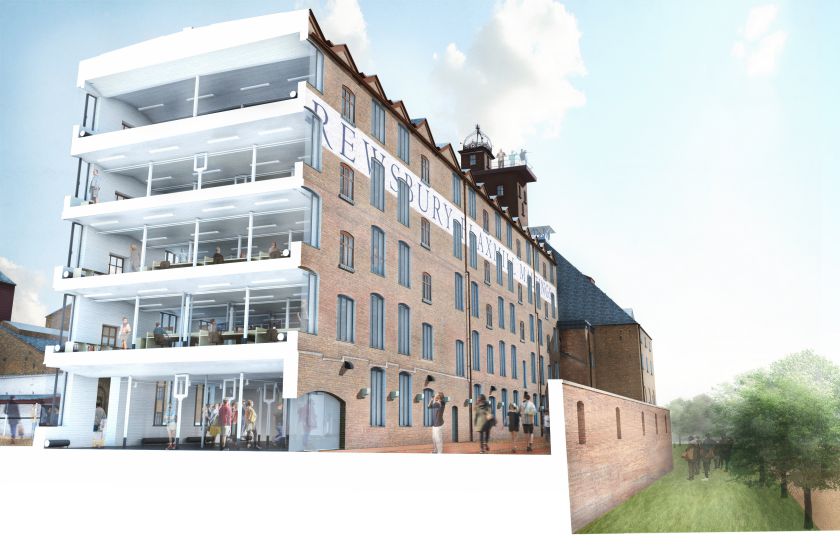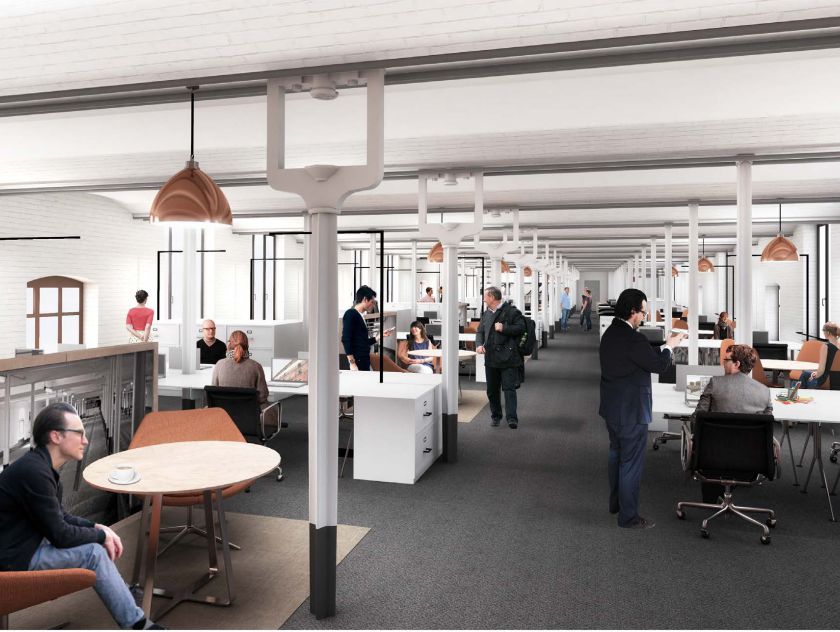By Carl Jones
There’s scaffolding everywhere. And I really do mean everywhere.
Miles of it. It’s propping up external walls, internal walls, window frames, doorways, floorboards, stairways, and lots more besides . . . like the world’s biggest Meccano kit.
And thank goodness that it is. For had the team at Historic England not stepped in when they did, Shrewsbury’s historic flaxmill maltings might well have crumbled to dust by now.
From the outside looking in, not much seems to have changed over the past decade, but as soon as you don a hard hat and hi-vis jacket to step inside, you find a hive of so far largely unseen activity.
Some conservationists argue that this landmark building, which has towered over Ditherington since 1797, is more important to the industrial heritage of Shropshire than the Iron Bridge.
It is, after all, the world’s first iron-framed ‘skyscraper’ which blazed a trail that the likes of the Empire State Building in New York, and the Burj Khalifa in Dubai, have since spectacularly followed.
And yet, for the past three decades, it has been the main player in a sad and sorry tale of abandonment, neglect, and spluttering false-starts.
Now, thankfully, it seems to be umpteenth-time lucky, with a £28 million renovation project under way to turn it into a £1 million ground floor visitor centre, plus 24,000 sq ft of luxury office space above.
The five-storey mill was built at the end of the 18th century for visionary owners John Marshall, Thomas Benyon and Benjamin Benyon. Back then, despite pushing the boundaries of established construction etiquette, it cost just £17,000.
For its first 90 years, it operated as a thriving flaxmill, bringing in flax from the fields of Shropshire and turning it into thread to be used for clothing.
Then, after a 10-year hiatus, it was reborn as an equally successful maltings, this time taking barley from the countryside to turn into ingredients for local breweries.
But since 1987, when the maltings closed down, the seven acre complex – which is home to no fewer than seven listed buildings – has stood derelict.
After a series of false starts from private investors, the site was bought back into public ownership around 2005 by what was then English Heritage.
Historic England has now taken over the freehold of the site, and is working closely with the Friends of the Flaxmill Maltings, and Shropshire Council, to give it a new lease of life.
Which brings us to why I’m standing above the roof trusses, with hard hat and fluorescent jacket, on a Shropshire Chamber of Commerce guided tour inside the grandfather of global skyscrapers. And why it’s taken so long for restoration work to swing into action…
Since internal shoring up and renovation work began in June last year, much has been achieved, and the team have been keen to show off what they’ve been doing.
Alastair Godfrey the project lead on behalf of Historic England, says: “To put it politely, over the past 30-odd years, this building has had a history of failure.
“And yet to me, maybe rather controversially, I believe it is more important almost than the Iron Bridge.
“The bridge was the first to use iron on a very vast industrial scale, but what we have at the flax mill is a quantum leap – from looking to use iron merely as a structural member, to using it for the construction of a whole building.
“Iron had been used for smaller components and individual columns of previous buildings, but this was the first time someone had looked to create an entire building out of what was then a new material.
“It’s completely home-grown; commissioned and designed here in Shrewsbury, and yet massively under-sold nationally. In fact, the flax mill is better known internationally than it is here in the UK.”
He adds: “I’m well aware that since the site became redundant there have been a number of false dawns, and that people drive by and can’t see anything has really happened for 10 years other than scaffolding holding up the external walls.
“There were three failed development attempts throughout the 1990s, and this was because developers who bought the site didn’t realise the complexity of restoring such a building.”
“This major restoration project, beginning with the main grade one listed mill, is now well and truly in progress.”
So how is it all going to work, and what’s the timescale?
Alastair says: “We are carrying out the work in two phases – the first phase is the structural repairs which will be completed by the end of 2018, and the second is the fit out of the main building, which will include an international quality interpretation and learning centre, plus a café, on the ground floor, which we will be giving to the Friends.”
Historic England’s vision is to see the upper four floors turned into a centre of excellence and collaborative hub for use by local creative businesses.
Alastair points to statistics which show that eight million working hours a year are currently being lost by Shrewsbury people who are travelling to work in surrounding towns and cities such as Birmingham, Manchester, and Telford.
“If we were simply to create a co-working space here at the flax mill which people were able to use just one day a week, that’s still a massive 1.5 million of lost hours we could save.
“We see this very much as a plan to create a new business hub for Shrewsbury. It’s not pie in the sky any more, it’s actually going to happen. The keys should be handed over by the beginning of 2021.”
Inside the building, the original cast iron pillars are still in an excellent state of repair, despite more than two centuries of diligent service. The same can’t be said, though, about the cast iron horizontal beams which sit between each of the floors.
Richard Benjamin, administrator and support officer for the Friends of the Flaxmill Maltings, explains: “Cracks can be seen in many of the beams.
“Engineers think these cracks are historical – they probably came about in the first 10 or 20 years of the life of the building. However, they have still got to be dealt with.”
Despite its reputation for cast iron innovation, there is also a lot of timber in the flax mill too. And this is another big problem for the renovation team.
Richard says: “There is a timber ring beam in the walls, and after 90 years of the wet maltings process, this has rotted. As a result, it is deflecting the weight to the outside of the walls, which is why you are able to see a lot of bulging.
“This is happening quite a lot, and is why the whole building is scaffolded. The scaffolding is holding it up. Each side ties to the other, with metal needles taking the weight of the building while all of the repairs are going on.
“It has been presenting something of a nightmare to the builders, who are having to work in quite claustrophobic conditions.”
Much of the strengthening work is concentrated, unsurprisingly, on the ground floor which bears most of the weight. All of the upper floor plates are being kept clear – apart from their trademark iron pillars – to meet listed building regulations. The original open-plan flavour of the building cannot be altered.
A close look at the exterior of the main mill reveals signs of its dual identity.
When it was converted into a maltings, many of the original flax mill windows were bricked up, and others were made smaller.
As part of the renovation, many of the bricked-up windows are being opened up – revealing some spectacular views - so that the completed scheme recognises both parts of the building’s industrial past.
And matching the past with the present is no mean feat, because the bricks in the flax mill are all over sized. Why, I asked? Because back then, developers were taxed by the number of bricks they used in a new-build, so opted for bigger, and fewer.
Even in the late 1700s, it seems sneaky tax dodges were clearly commonplace…
The kiln from its maltings days which sits at the end of the mill will be retained and restored as part of the restoration project, and the building’s highest point – the tower and coronet created to mark Queen Victoria’s diamond jubilee in 1887 – will be a public viewing point, offering spectacular views of Shrewsbury, The Wrekin the Welsh hills and far beyond.
Steam engines were once housed at each end of the site, and the track where they used to run can still clearly be seen. Like all the historic storytelling quirks around the building, they will be retained.
Alastair Godfrey says: “The DNA of all the world’s iron framed buildings comes right back to this site and we have to celebrate it. This should be a marketing person’s dream.
“Our master plan for this whole seven-acre site is pretty much fixed. We are looking at a combination of commercial use in the main mill, residential use in the cross mill, and more residential space to the front and back of the site.
“But we are not talking about a high density residential scheme here. There are three Grade One listed buildings here, so what we do has to be of top quality, leaving a legacy for both Shrewsbury, and Historic England.”
Back in the day, of course, most of the goods were shipped into the mill by water. The Shrewsbury and Newport Canal ran right alongside the building, and in a nod to this heritage, the route of this waterway will remain undeveloped.
Who knows, if the canals trust succeeds in its ambitious bid to reopen the route, the way could be clear for water to again be flowing past the mill one day.
This year, though, the focus remains on making the main building stable, fitting fresh beams on the ground floor, and ensuring the external walls – which seem surprisingly slight when you see them up close, given the scale of the construction – are all safe and sound.
The team say there have already been a number of expressions of interest from companies looking to reserve office space in the office floors, but they’re not marketing it yet. It’s expected to be the second half of this year before they get round to appointing an official development partner.
For the Friends of the Flaxmill and Maltings, it’s as if they’ve won the lottery. Indeed, Lottery money makes up much of the financial support package.
But for Richard Benjamin, there’s one last thing which would be the cherry on top of the cake.
“As far as old photographs go, we only have them going back to its time as a maltings – nothing from its use as a flax mill.
“This is our Holy Grail; we can’t believe they don’t exist somewhere in an attic. Find one of those for us to provide the missing piece of the jigsaw, and you might just get a floor of the building named after you!”

Chris prepares for change
Online auction is live
Trustees boost final total

Jubilee Tower has been restored and scaffolding is taken down
Service will support companies considering new overseas markets
Two key appointments announced at Telford company
New operations manager appointed by insurance broker
Proposed facilities would create up to 97 new jobs
Fire and carbon monoxide protection experts launch support initiative
Accountants announce three senior promotions
Small office and workshop spaces prove popular
Big Town Plan Festival on the way
Initiative launched to help Shropshire businesses plan for the future
Engineering student is promised subsidised studies and full-time job
Shropshire Chamber welcomes two more high-profile businesses
Plans revealed for £40 million investment to achieve climate objectives
One of the first in the UK to be diagnosed now supporting NHS donation scheme
Firm can now expand and take on new staff